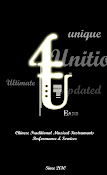
Erhu 二 胡
(Chinese violin) is a bowed two-stringed vertical fiddle has a long history of more than 1,000 years. This major instrument in Chinese orchestra plays the same role as the violin in Western orchestra. Capable of making expressive and haunting sound. Erhu is extremely popular in China today as a medium for both traditional and contemporary music as well as plays an important role in both solo and orchestral performances. The erhu bow is placed between its two strings namely the inner and outer strings and moving horizontally over the two vertical strings. Traditionally the two strings are made of silk, but metallic strings are also used.. The tone of Erhu resembles a human voice. Besides, it can imitate many natural sounds, such as bird and horse. As a very expressive instrument, Erhu can play not only melancholy tunes, but also joyful melodies.

Pipa 琵 琶
has four-stringed lute and pear-shaped body, one of the oldest Chinese musical instruments which appeared in Chinese written texts of the second century BC. The Chinese characters "pi" and "pa" stands originally for the two finger playing techniques(ie plucking at the string forwards and backwards, respectively). This instrument has extremely wide dynamic range and is remarkably rich and expressive.

Dizi 笛 子
made by bamboo, has one blowing hole(where the air is blown in to make sounds), one affiliated hole(which is covered by the membrane of the bamboo or bulrush, the air makes the membrane vibrate, which can produce clear and smooth tones) and six sound holes. Although the structure of the flute is simple, it has a history of more than 7,000 years. About 4,500 years ago, designers began to make flutes with bamboo instead of bone. The flute became the main part of the accompaniment, and was also indispensable in folk and ethnic dramas, has a rich performance spectrum. The flute not only can it play bright and sonorous tunes, but also cheerful dancing music and peaceful ditties. In addition, it can imitate various sounds in nature such as the twittering of birds.

Guzheng 古 筝
(Chinese Zither) is a logn-bridged instrument with 21 or more strings which has the lilting and evocative sound. Guzheng originated during the Warring Period more than 2,500 years ago in China . The earliest known versions were constructed with a bamboo frame and used old silk strings(replaced with nylon strings now the day). Its scale was pentatonic, using the notes DO, RE, MI, SO, and LA with a major note for each of its five strings.Guzheng became very popular in the imperial court and among the common people. In addition, many new forms of Guzheng appeared through cultural exchanges with Japan , Korea , Mongolia , Vietnam and many other Asian countries.

Yangqin 扬 琴
(Chinese Hammered dulcimer or Chinese Piano) was brought to China from the Middle East and it is played with two lightweight bamboo strikers(also known as hammers) with rubber tips. Since the 1950s, steel alloy strings have been used in order to give the instrument a brighter, and louder tone. Yangqin can have as many as five courses of bridges and may be arranged chromatically, used both as a solo instrument and in ensembles.

Ruan 阮 咸
a round-shaped plucked-string instrument which comes in a family of five different sizes.The instrument can be played using a plectrum similar to a guitar pick, produces a mellow tone. However, in Chinese orchestras only the zhongruan(medium ruan) and daruan(large ruan) are commonly used, to fill in the tenor and bass section of the plucked string section.

Sheng 笙
is a free reed wind instrument consisting essentially of vertical bamboo pipes bound together with ropes or wooden frame. Sheng's sounds bright and sweet in tone. Among the traditional piped instruments, Sheng is most capable of performing harmonies. Sometimes in grand ethnic orchestras, Sheng can play alternately blowing and inhaling, and can produce a continuous sound without pause as well as play at least two or more notes at the same time.
